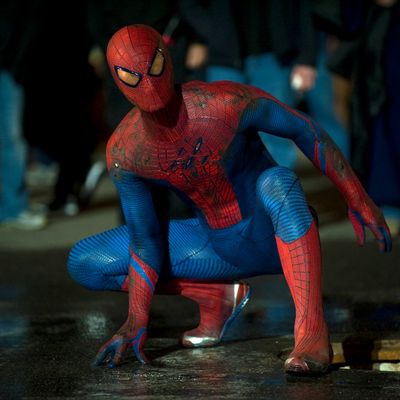
Increasingly, moviegoers have to deal with the disorienting effects of rapid cultural recycling. As the superhero blockbuster has taken over America, the concept of the reboot (which, along with its sibling the retcon, has maddened comic-book readers for decades) has become all too familiar to multiplex audiences. The last decade alone has seen the Batman, Superman, Hulk, and Ghost Rider franchises all hit the reset button, but it’s arguable that The Amazing Spider-Man contradicts its own Hollywood canon more than any other superhero film. Here are five ways in which the movie diverges from the three Sam Raimi–Tobey Maguire–Kirsten Dunst attempts that preceded it.
1. Peter Parker is not a nerd.
When Spider-Man was introduced in 1962, he was a total egghead. He made Eddie Deezen look like a player. We’re talking sweater vests, owlish glasses, and a bedroom filled with only beakers and books. In Sam Raimi’s 2002 Spider-Man, this was the character that Tobey Maguire tapped into, all stammers, scowls, and greasy pores. At the turn of the millennium, though, the Ultimate Spider-Man comic recast Parker with a hip haircut and HTML skills; Andrew Garfield’s arty outsider takes him even further into the realm of Misunderstood Pinup. He doesn’t wear glasses, he skateboards to school, and his room is appointed with a Mark Gonzales poster and reams of Ilford paper.
2. The webs don’t spurt out of his body.
When details about the first Spider-Man movie began to emerge, one faction of fandom was so appalled by the concept of Parker’s radiated ability to self-generate long strands of milky fluid that it started a website, the no-longer-active www.no-organic-webshooters.com. (URL investors, act now!) The new film’s mechanical web-shooters, which Parker mysteriously builds from materials in his bedroom in Queens, are actually the comic-book standard. The Amazing Spider-Man also gets it right by limiting the hero to swinging only from webs that connect underneath horizontally projecting bridge girders and crane arms. If he tried to swing on webs that connected to building sides, he would crash instantly. Think about it.
3. No Osborns.
In the comics and in the Sam Raimi trilogy, the father-and-son team Norman and Harry Osborn are known for their mind-boggling reddish-brown cornrows, and for their obstinateness in putting on Green Goblin costumes. In the comic, Peter Parker met Harry when they were both freshman at Empire State University; in Spider-Man, they went to high school together, and things got hairy when Harry’s dad was impaled while fighting Spider-Man. In Amazing, the only mention of either Osborn is from Curt Connors (who was Parker’s physics professor at Columbia in Spider-Man 2 and 3, but now is a herpetologist for Osborn’s scientific research company, Oscorp). “People die,” says Connors, cryptically, “even Norman Osborn.”
4. Aunt May is not a dithering old biddy.
Another Ultimate Spider-Man contribution was to transform Uncle Ben and Aunt May into relatively hip baby boomers, the kind whose commune experiments didn’t quite work out but who still like to put on Hot Tuna records now and again. Now they are portrayed by Captain Willard (Martin Sheen) and Norma Rae (Sally Field). She’s not quite the ex-flower child of the Ultimate comic, although she does ask Peter to bring her organic eggs from the store.
5. All Gwen Stacy, zero Mary Jane
In 1965’s Amazing Spider-Man No. 31, Peter Parker enrolled in college and met Gwen Stacy. For a while, the near-constant presence of Mary Jane Watson often seemed to undermine the seriousness of Peter and Gwen’s relationship, and the three of them sometimes fell into Archie-Betty-Veronica shenanigans. But Gwen dragged the squarish Parker into the spirit of the times: She went to Ralph Nader rallies, celebrated Betty Friedan’s birthday, and tried to drag him to see I Am Curious (Yellow). And her buckskin dress, go-go boots, and bangs won the hearts of a generation of readers.
In 1973, the Green Goblin threw Gwen Stacy off the Brooklyn Bridge, Spider-Man caught her with his webbing, and her neck snapped. She’s since returned, more than once, as a clone, but there’s still something creepy about the rejuvenation of a character who has loomed larger in death than she did in life, kind of like if Laura Palmer and Billy Briggs suddenly headed up a rom-com. Still, congratulations to Spider-Man and his new, old girlfriend. If they can’t make it last, there’s always hope for Betty Brant in 2022.
Sean Howe is the author of the forthcoming Marvel Comics: The Untold Story.

